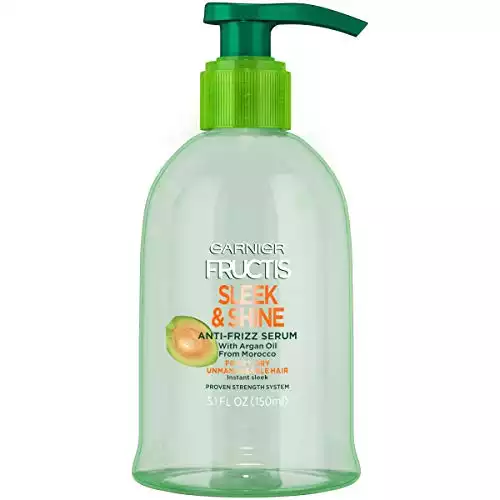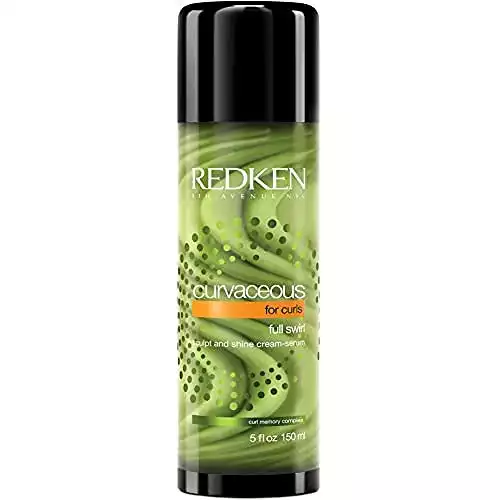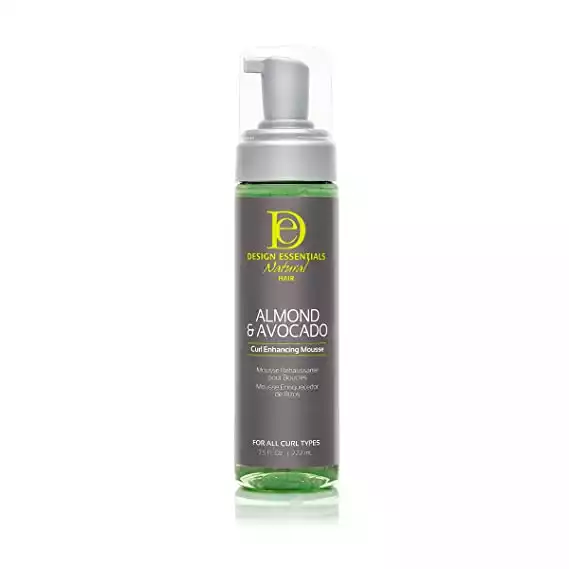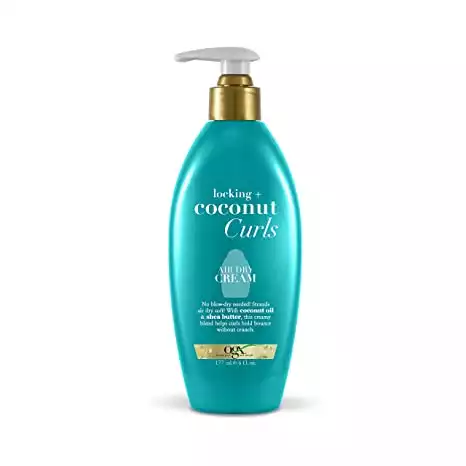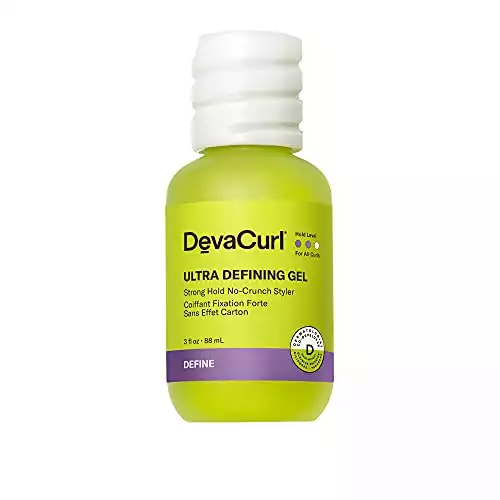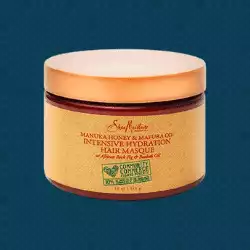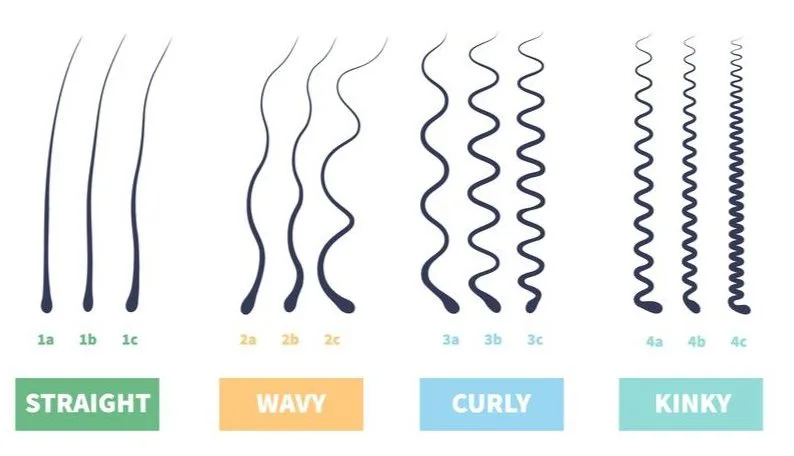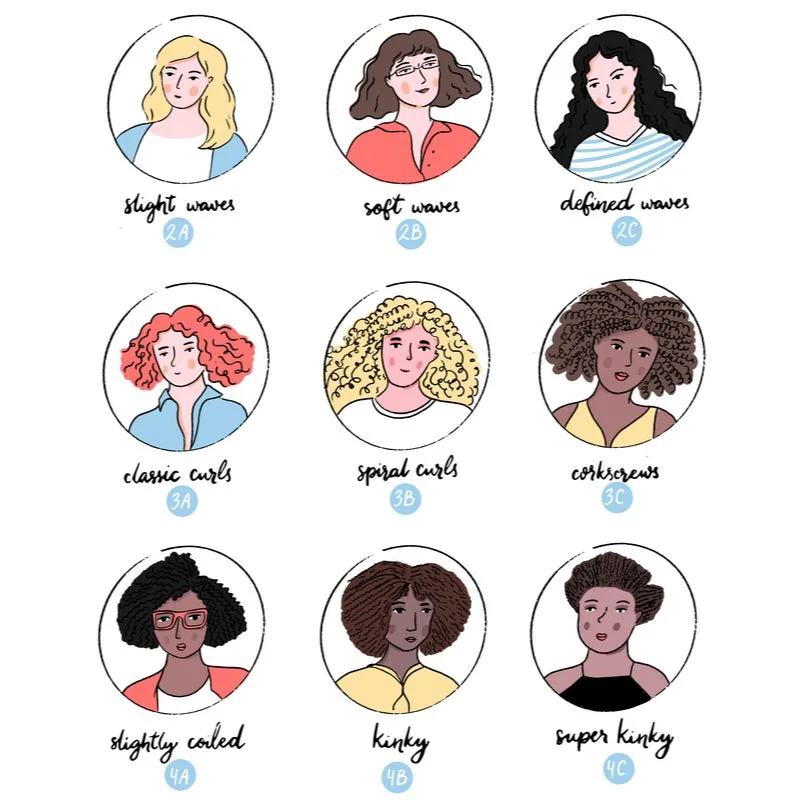Jump to:
Ah, the trusty old hair type chart. While a quick Google search may yield a few results, we think none are as easy to read as ours. Take a look at our chart below to learn how to quickly determine what your hair type is.
Looking for a Hair Type Chart?
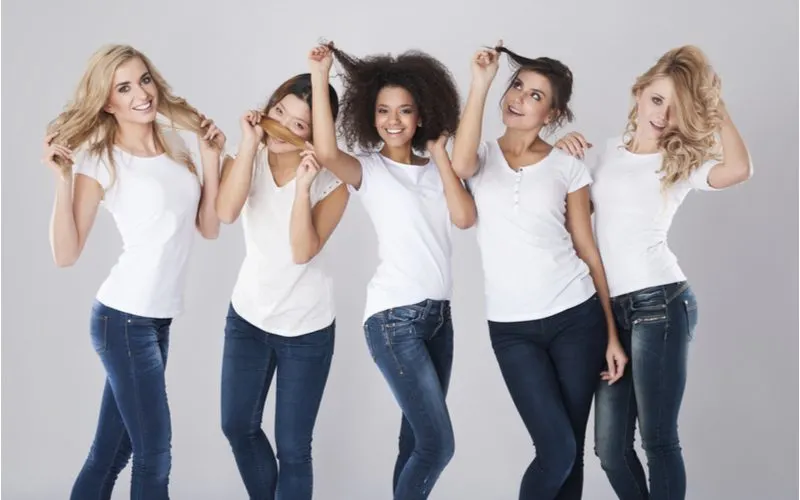
Gpointstudio/Shutterstock
Why exactly do you need a hair type chart? Well… hair typing is the key to developing the perfect hair care routine for your strands. If you’re not sure what your hair type is, there’s a good chance you’re using the wrong products and style techniques.
If oiliness, frizz, or chronic dryness are plaguing your strands, finding out your actual hair type will help you correct the issues and get on the path to better hair health.
It’s not always easy to determine your own hair type, even with the best descriptors. Many types overlap and have similar characteristics, making it a challenge to assign your locks to one category. That’s why we created a simple chart that will lead you to your official hair type without the confusion.
Before you find your hair type in the chart below, you’ll need to determine if your hair is fine, medium, or coarse in texture and circumference. This will help you narrow down your actual hair type.
Pull a strand of your hair out and examine the thickness of the strand in comparison to a piece of thread.
- Fine: Strands are thinner than a piece of thread
- Medium: Strands are roughly equal to a piece of thread
- Coarse: Strands are thicker than a piece of thread
With your hair’s thickness in mind, take a look at the chart below to determine what your hair type is!
Hair Type Chart: What’s Your Hair Type?
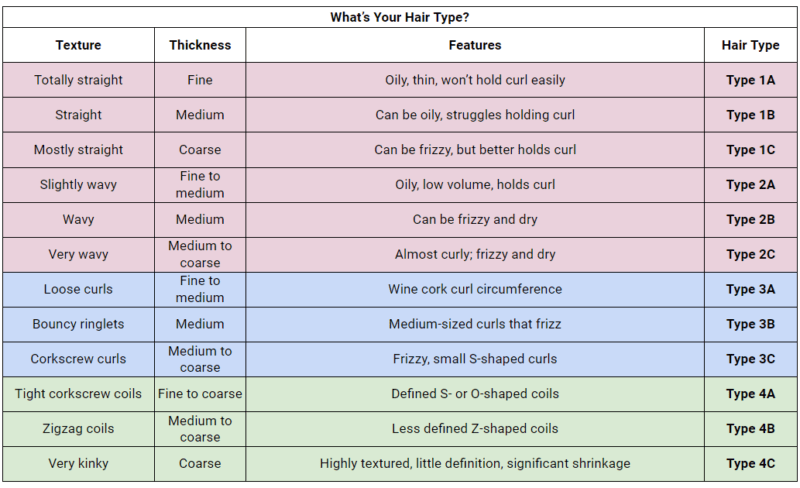
You should be able to pinpoint your hair type with this chart. If you’re still not quite sure which subtype your hair falls under, keep reading to learn more about each type and subtype.
A Closer Look at Each Hair Type
It’s essential that you determine your hair’s general type number (1, 2, 3, or 4) and your subtype (A, B, or C) to zero in on your hair’s specific needs and traits. Certain types of hair products and style techniques work wonderfully for some hair types, but can weigh down, dry out, or overload others.
Here’s a closer look at each type and subtype to make it easier to pinpoint yours. We’ll talk about the types of hair products and styling techniques each subtype should use so you can start building the perfect hair care routine for your specific type!
Type 1: Straight Hair
Type 1 hair is always straight. There is no trace of wave or curl in type 1 hair. Type 1 hair tends to have these characteristics:
- May get oily fast without any physical bend in the hair to slow oil traveling down strands
- Air dries with straight texture
- May struggle holding a curl when heat styled
If you have straight hair, you will fall under one of the 3 subtypes: 1A, 1B, or 1C.
- Type 1A: Hair is totally straight with a fine, thin appearance
- Type 1B: Hair is straight with medium thickness and density
- Type 1C: Hair is mostly straight with coarse texture and frizz
Styling Type 1 Hair
Type 1 on our hair type chart should use lightweight styling products to avoid weighing the hair down with heavy gels and creams designed to deliver additional support and moisture for hair types with more texture.
Since straight hair doesn’t need to “hold” any wave or curl pattern, you really don’t need mousse, gel, or curl cream for this hair type.
We recommend using a lightweight, frizz-fighting, non-greasy hair serum for type 1 hair. Our top pick for type 1 hair is Garnier Fructis Sleek and Shine Anti-Frizz Serum.
It delivers nourishment, shine, and better manageability without weighing the hair down or increasing oiliness.
Use it in damp or dry hair for more shine and sleekness that isn’t oily or greasy. Remember that type 1 hair will dry to the same straight finish whether you air dry or blow dry it. Since blow-drying too often or with too much heat can damage your hair, it’s best to air dry whenever possible.
If you plan to heat style waves or curls, or just want to blow dry your straight hair for a shinier finish, make sure you apply a heat protectant product first. Blow-drying at a lower heat setting will also help you avoid heat damage on straight hair.
Type 2: Wavy Hair
Type 2 on our hair typing chart is wavy – somewhere in between straight and fully curly. There are bends and waves in the hair that don’t form complete curls. Type 2 hair tends to have these characteristics:
- May get oily fast, especially if the hair is fine
- Frizz is common, especially with medium and coarse wavy types
- Air dries wavy and may be enhanced to curls with products
If you have wavy hair, you can determine your subtype by the characteristics below. The extent of the wave in your hair will help you find your subtype.
- Type 2A: Hair is fine with slight bend and wave; may require products to fully wave
- Type 2B: Hair is obviously wavy, may be frizzy, and has a medium thickness
- Type 2C: Hair is very wavy, almost curly, tends to be frizzy and has a coarse texture
Styling Type 2 Hair
Type 2 hair may vary in the degree of waviness, but all type 2 hair can benefit from using the right types of products and styling techniques. Wavy hair is in between straight and curly.
So you may choose to style your hair naturally, with enhanced waves, flattened and straight, or heat styled with curls. We recommend using a lightweight frizz-eliminating mousse and hair serum in damp type 2 hair before air-drying or blow-drying.
Lightweight mousse provides just enough hold and structure for your waves to intensify without being weighed down with too much or too heavy a product.
Try Design Essentials Curl Enhancing Mousse to bring out the intensity of your waves without weighing them down. Layer with Redken Curvaceous Full Swirl Cream Serum to add shine and strengthen your waves without making them greasy.
Scrunching waves once you’ve applied your products will keep them grouped naturally and help add a little more structure to the bends. Once you’ve applied and layered your products, scrunch upward from the ends of your hair to revive the waves and help them set as they dry.
Type 3: Curly Hair
Type 3 on our hair type chart is curly with S-shape curls present throughout. The size and intensity of the curl varies by subtype (3A, 3B, or 3C), but type 3 hair always shares these characteristics:
- Curls have a defined S-shape
- Curls are bouncy, defined, and voluminous
- Tends to be frizzy and dry without lots of shine
If you have type 3 hair, you’ll fall under one of the 3 subtypes for this category according to the texture of individual strands and the way your curl groups behave.
- Type 3A: Loose, defined curls about the circumference of a wine cork
- Type 3B: Medium-sized curls about the circumference of a permanent marker
- Type 3C: Tight, corkscrew spiral curls about the circumference of a pencil
Styling Type 3 Hair
Styling type 3 curly hair requires layering the right products in the proper sequence to get the best results. Applying the right products will help you achieve a more uniform curl texture and shape with minimal frizz.
Since curly hair can range from fine to coarse, your product needs will depend on your subtype.
Type 3A tends to be fine to medium in texture, so it needs lightweight styling products. Try Design Essentials Natural Curl Enhancing Mousse for lightweight hold that acts like scaffolding for your loose, bouncy curls.
Layer with an airy hair milk like milk_shake Incredible Milk for more shine, strength, and moisture without weighing curls down.
Type 3B tends to be medium in texture, so you can use slightly heavier products to manage and style your curls. This subtype is more tightly curled than 3A, so it tends to be a little drier. Work around that by using OGX Locking + Coconut Curls Air Dry Cream in your damp hair.
It does triple duty: Adds moisture without weighing down tight curls, provides light structure for your curls, and nourishes to minimize frizz and breakage.
Type 3C tends to be medium to coarse in texture, making chronic dryness and frizziness a real problem for this subtype. Fix it with powerful hair products that deliver plenty of moisture along with a stronger hold to manage and define your curls.
DevaCurl Define and Control Styling Cream is the best product we’ve come across for 3C curls. It is strong enough to support and hold even the tightest curls, provides tons of moisture, and helps eliminate frizz associated with dryness.
Learn more about layering products and styling curly hair to avoid frizz, tangles, and poor curl definition with our guide to The Curly Girl Method.
Type 4: Coily or Kinky Hair
Type 4 on our hair typing chart (coily or kinky hair) is much springier than type 3 curly hair. While bends and curl patterns are sometimes obvious in type 4 hair, the S-shaped curls of type 3 hair are not present.
Instead, the curl pattern ranges from a defined O-shaped coil to a tight kink pattern without defined coils. Type 4 hair has the following general characteristics:
- Texture from extremely tight corkscrew to angled zigzag pattern
- Significant shrinkage when dry is a common issue
- Hair tends to be coarser, but very fragile and dry due to the strand shape
- Hair soaks up moisturizing products quickly
If you believe you have type 4 hair, you’ll fall under one of the 3 subtypes for this category: 4A, 4B, or 4C.
- Type 4A: Coils have an S- or O-shape, are well defined, and about the circumference of a coffee stirrer; limited shrinkage; fine to coarse texture
- Type 4B: Less defined coils, may have a Z-shape (zigzag pattern); may look like a mass of textured hair with a few defined coils; some shrinkage; medium to coarse texture
- Type 4C: Extremely tight coils/kinks without much definition; may look like a mass of textured hair without defined coils; shrinks up to 75% as it dries; coarse texture
Styling Type 4 Hair
Type 4 hair ranges from medium-fine to very coarse and wiry. This means choosing the right products for your type 4 hair requires tailoring your choices to your specific subtype. One thing all the type 4 subtypes have in common is their need for lots of moisture.
Type 4A hair tends to be very dry and porous. This type benefits from using products that deliver plenty of hydration, but since it’s high porosity, it also loses moisture fast. The key to managing that is using highly moisturizing products followed by a sealing oil to keep hydration locked into strands.
Try SheaMoisture Intensive Hydration Masque for moisture, DevaCurl Define and Control Styling Cream for durable hold that defines your coils, and a little coconut oil to seal in all the good stuff.
Type 4B hair is also very dry and porous, but it’s also less defined and more prone to shrinkage when it dries. Combat this with proper moisture and products with strong hold that supports and cradles your coils for better definition.
Like type 4A, SheaMoisture’s Intensive Hydration Masque followed with coconut oil is perfect for delivering deep hydration for this hair type.
For an intense hold that helps bring out definition in your coils and limits shrinkage, try Got2B Ultra Glued Invincible Styling Hair Gel worked evenly throughout your hair while it’s damp.
Type 4C hair is the kinkiest hair type. With almost no natural definition, you can transform your hair into better-defined coils that polish and highlight your hair’s texture when you use the right products. Every product you use should deliver hydration, from your shampoo to your styling products.
Apply coconut oil, which can penetrate strands, before shampooing and conditioning. DevaCurl Define and Control Styling Cream will support and help define more coils, which cuts down on shrinkage.
The Got2Be styling gel linked for type 4B is also a great choice for 4C. Protective styles like dreadlocks, goddess locs, sisterlocks, tribal braids, and other protective natural hairstyles are especially useful for this hair type.
Things to Consider
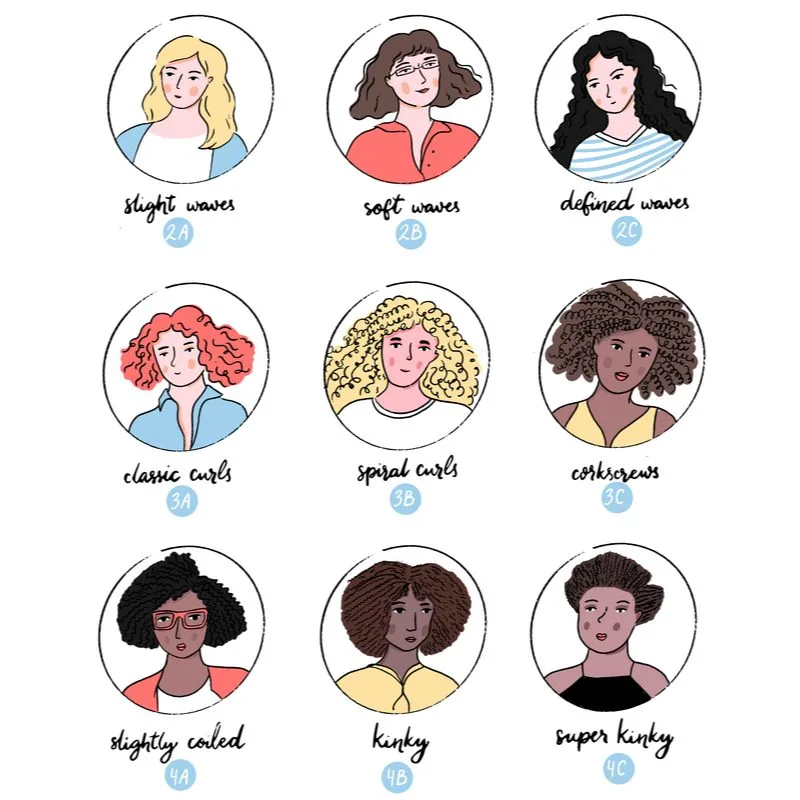
Anna Kutukova/Shutterstock
Hair typing isn’t always easy, but hopefully the chart above made it less challenging to determine yours. Now that you’ve pinpointed your specific hair type and have seen a few recommendations for managing and styling it, let’s look at a few things you should consider so you can better understand your hair type:
- The straighter your hair is, the oilier it naturally is. Waves and curls are physical barriers that prevent sebum (oil) from traveling down your strands and making your hair appear greasy. If you have type 1 (straight) hair, your hair will naturally get oily faster because the oil can freely travel down the strands. Use less moisturizing products and more lightweight, nourishing products to combat this.
- Fine hair of any type is easily weighed down. Whether you have fine hair that is straight, wavy, curly, or coily, it’s always going to be overwhelmed by heavy hair products. Firm-hold gels, intensely moisturizing products, and heavy natural oils may prove to be too much for fine hair. Experiment with small amounts of moisturizing products if your fine hair is dry.
- Experiment to find your personal favorite products. We’ve included some of our favorite product recommendations for each hair type in this guide, but we encourage you to experiment a little. If one product doesn’t deliver the kind of results you’re looking for, try another with the properties your hair type needs (for example, any intensely moisturizing product with moderate hold should work for type 4A hair).
- Pay attention to moisture needs. Even straight, fine hair needs proper hydration and moisture. Signs of chronically dry hair or high moisture loss include stubborn frizz, hair that soaks up moisturizing products almost instantly, flyaways, increased breakage, and a straw-like texture. If you’re noticing any of these indicators of dryness, combat it with a little extra moisture via coconut oil, hydrating shampoo and conditioner, hair milk, or leave-in products.
- Subtype is most important for curly and coily hair types. While it’s helpful to know your hair type and subtype if you have straight (type 1) or wavy (type 2) hair, it’s most important for curly (type 3) and coily (type 4) hair. There’s little difference between the moisture, hold, and product needs for type 1A, 1B, and 1C, but there’s a huge difference between the needs for type 4A, 4B, and 4C. Always follow the specific recommendations for your hair type and subtype if you have curly or coily hair.
Was Our Hair Type Chart Helpful?
So there you have it — the best hair type chart on the web. We hope you’ve successfully found your hair type, subtype, and styling recommendations with our guide! Next time you wash and style your hair, use the tips we shared for your hair type.
We think you’ll see a noticeable difference in the health, appearance, and manageability of your hair with these type-specific tips!

